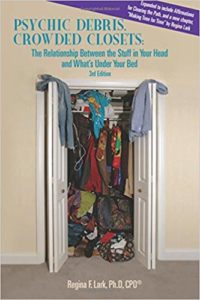By: Regina Lark, Sheri Samotin, Noelle Valentino

There are many challenges to dismantling an estate – from recovering important documents and hopefully avoiding probate, to deciding what to do with elegant (but worthless) tchotchkes and table linens. The size and scope of some projects can be daunting, even for the most dedicated of adult children, who likely have too much stuff in their own homes to tackle the clear-out of their parents’ household. There are so many moving parts, and often requires a team of experienced, dedicated professionals who work together to settle the estate and get the home ready for sale. An estate attorney, a realtor, and a good handyperson ought to be part of the team.
Dealing with the contents of the property is a different matter. Three professionals: a private fiduciary, an appraiser/valuator of tangible personal property, and a company that specializes in de-cluttering and downsizing, walk us a through their process to dismantle an estate, and the considerations that must be made when helping a family going through this process.
How to Get Started: Build Your Team
Sheri Samotin, Private Professional Fiduciary, LifeBridge Solutions
One of the most frequent comments I hear in my first conversation with a prospective client is, “I’m overwhelmed.” If the prospect is the family member in charge of administering a trust or estate, they have many unfamiliar tasks to handle. Sometimes, I am my own
charge of administering a trust or estate, they have many unfamiliar tasks to handle. Sometimes, I am my own “client” if I am serving as a designated trustee or administrator. I must make the magic happen regarding clearing and distributing the personal property in accordance with the trust and/or will.
“client” if I am serving as a designated trustee or administrator. I must make the magic happen regarding clearing and distributing the personal property in accordance with the trust and/or will.
After I have reviewed the relevant documents, it’s time to lay out my strategy. Typically, the first step is to go through the home to locate any valuable items that could “grow feet” and disappear. Those items need to be secured. In addition, we search every nook and cranny for any papers that might be needed to support prior tax returns or to help us file a return. In one recent case, we
thought the decedent was a single man. In fact, when going through his papers, we learned that he had been briefly married as a young man and that the marriage was annulled. Sometimes we are looking for information related to the “family tree” to make sure everyone who is legally entitled to notice receives it. At the same time we are going through the paper, we make “shred” bags for documents that don’t need to be saved but require proper disposal.
Once the paper monster has been tamed, it is time to get an idea of the value of the personal property.
Valuing Tangible Personal Property, Appraisal and Disposition at Auction
Noelle Valentino, Fine and decorative arts specialist; household contents appraiser, John Moran Auctioneers & Appraisals
More often than not, the bulk of the value of an estate’s tangible personal property can be found in just a handful of items. It is important to engage a specialist early in the process to identify the items of significance before they are claimed by relatives, given away, donated, or worse. A qualified tangible appraiser will produce an inventory of household contents, or a formal appraisal report, depending on the needs of the estate. The intended use of the document must be disclosed in the report: equitable distribution, charitable donation, estate tax filing, or something else.
 For IRS purposes, estates approaching the exemption limit will require a household contents appraisal. The IRS defines art broadly: jewelry, paintings, silver, rugs, decorative objects and more. Outside of tax regulation, there are often issues that arise due to family reasons and an estate appraisal may be recommended to avoid later conflict. For the purposes of distribution among beneficiaries, it is helpful to discuss a minimum value threshold with the appraiser. A fair market value of several hundred dollars is often a good starting point for an object’s inclusion in the report.
For IRS purposes, estates approaching the exemption limit will require a household contents appraisal. The IRS defines art broadly: jewelry, paintings, silver, rugs, decorative objects and more. Outside of tax regulation, there are often issues that arise due to family reasons and an estate appraisal may be recommended to avoid later conflict. For the purposes of distribution among beneficiaries, it is helpful to discuss a minimum value threshold with the appraiser. A fair market value of several hundred dollars is often a good starting point for an object’s inclusion in the report.
Appraisals are considered legal documents and can be relied upon by an attorney, the court, or the IRS. Selecting a personal property appraiser who is USPAP compliant, with membership in one of the three preeminent appraisal organizations, is imperative. Qualified appraisers in your area can be located on the websites of the Appraisers Association of America, International Society of Appraisers, or American Society of Appraisers.
When considering the eventual disposition of assets from an estate, an auction house can also be helpful in identifying the items of greatest value in the home. With the intent to secure new consignments, they will provide free auction estimates. With that said, auction houses are likely to include only the items valued over $1,000 and appealing for bidders in today’s market. Note well that an auction estimate does not take the place of an appraisal. It is however, an advisable sale venue for estate property due to its the broad reach and rapid mode of sale, together ensuring fair market value has been achieved.
When the ‘good stuff’ is gone… Now what?
Regina F. Lark, Ph.D., downsizing and organizational specialist, A Clear Path, LLC
The typical household contains thousands of pieces of tangible personal property. Every room has stuff – some rooms have more stuff than other rooms. Drawers and cupboard and closets are filled with flatware, dishes and clothes. Even if considerable downsizing had already happened, there’s no getting around this fact: we all have to deal with our clients’ stuff.
To get the job done in an efficient and timely way, look for a professional organizing/downsizing company with access to a broad range of resources to complete the dismantling of an estate. Find out what they know, and who they know, when you ask these questions:
- What does your business liability cover?
- Do you have a project management fee?
- Are you able to ship items across, or out of, the country?
- Have you encountered a hoarding situation? If so, how do you handle the massive volume of ‘stuff?’
- Do you have the ability to sell what the auction house doesn’t want?
After the auction house reviews and removes what I call the “big ticket” items, the remainder of the household contents can be photographed (to attach to donation receipt), packed-up, and hauled to the nearest non-profit. If removal is all that’s required, a good downsizing company can have the estate cleared and ready for the realtor to put on the market.
Another option is working with a traditional estate sale company. They usually spend two weeks tagging everything in the house, around the yard, and in every kitchen drawer. Many estate sale companies charge a percentage of the sale’s gross profits. For example, if the company charges 40% of gross profits and the sale yields $10,000 then you will owe the company $4,000. Be sure to ask about any additional services such as trash removal, post-sale clean-up, etc. If the estate is thick with clutter, does the estate sale company address that, too?
Over the past couples of years, online estate sale auctions have become wildly popular, and MaxSold, a Canadian company with a robust platform, has generated a large footprint in the United States. The concept is simple – an organizing team catalogs every item in the house into what are known as “lots,” distinct groupings of one or more items sold at auction– creating lots of lots! The sale is live online for 7-10 days and every lot begins at $1 (yes, one dollar). The bidding is particularly fast and furious on the final day of bidding. The ultimate split is 70% to the estate and 30% to Max Sold. If a fiduciary hires a team of professionals to dismantle an estate, it will likely come close, break-even, or make money on the sale of the remaining tangible personal property, and quite often, offset the cost of their service.
Conclusion:
Due diligence regarding the estate’s personal property is an important aspect of fiduciary duties. Sentiments tend to run high when it comes to the “stuff.” Suspend bias and remain objective with assets you are unfamiliar with, calling in experts where appropriate. Moreover, encouraging your clients to update their estate plans ahead of time, including a review of existing appraisals with personal property assets, as this can prevent later confusion. Proactive steps in identifying items of value and having a working plan for the disposition of tangible personal property can mitigate the risks and avoid family conflict, or a professional headache.


 Moving is always a stressful endeavor no matter how old you are, and it gets even tougher with years of memories and possessions accumulated in the home. Statistics from
Moving is always a stressful endeavor no matter how old you are, and it gets even tougher with years of memories and possessions accumulated in the home. Statistics from  4. Experience and Certification
4. Experience and Certification

 A senior move manager is involved in unpacking your items. The manager will ensure all possessions are moved to the appropriate rooms and quickly unpack items you need immediately, such as crucial documents and medications. The manager will also arrange all items to optimize storage.
A senior move manager is involved in unpacking your items. The manager will ensure all possessions are moved to the appropriate rooms and quickly unpack items you need immediately, such as crucial documents and medications. The manager will also arrange all items to optimize storage. A good rule of thumb is to prepare for a move in advance and not wait until the 11th hour to start
A good rule of thumb is to prepare for a move in advance and not wait until the 11th hour to start  not fetch much at a yard sale should also be donated where they will be more helpful, like at a children’s camp.
not fetch much at a yard sale should also be donated where they will be more helpful, like at a children’s camp. 
 Start preparing for your move in advance, perhaps even months ahead of time. If you know you want to downsize, begin working on the following now. Doing so will help you tremendously when the time comes to start packing.
Start preparing for your move in advance, perhaps even months ahead of time. If you know you want to downsize, begin working on the following now. Doing so will help you tremendously when the time comes to start packing. Group your items by room, not by type. For instance, if you’ve visualized a small library in your living room, but you also have some books you like to keep close to your bed, then don’t be afraid to separate those. The same goes for everything else — from pillows to artwork.
Group your items by room, not by type. For instance, if you’ve visualized a small library in your living room, but you also have some books you like to keep close to your bed, then don’t be afraid to separate those. The same goes for everything else — from pillows to artwork. 